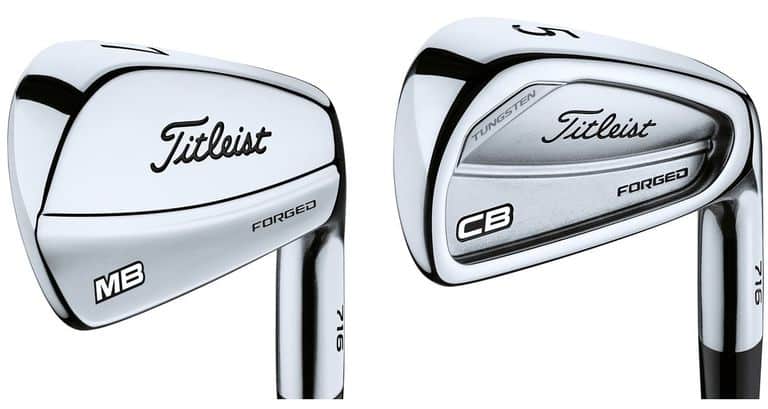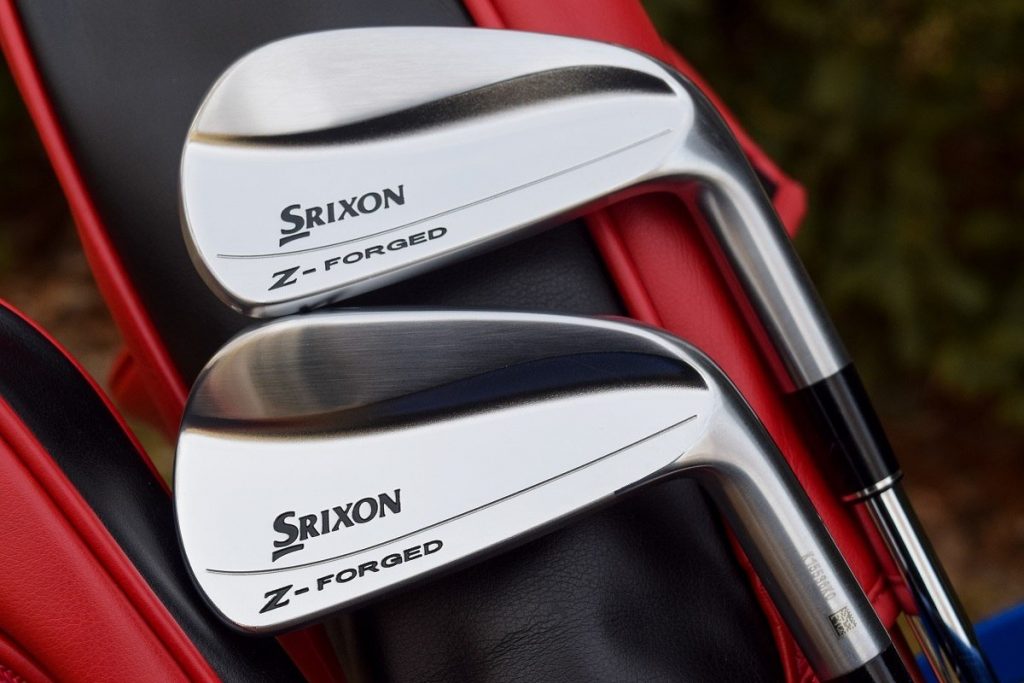Many golfers have the perception that playing with blades is the trademark of a good player.
As soon as they see someone using those shiny, intimidating, steak knife-type clubs, they automatically assume the person must be an elite ball-striker and top-level golfer.
Why? Well, for a long time the perception has been that the best players in the world – such as those who compete on the PGA and European Tours – use blades, therefore amateur players who do likewise must be pretty handy.
But the biggest question many golfers have on this topic (and one that has likely brought you to this article) is: can you play high-level golf with game improvement irons, or should you learn to play golf with blades in order to become a better player?
Learning to play golf with blades – otherwise known as forged muscle-back irons – is not a requirement to becoming a good player. While they offer more control to shape the ball in the air, they are less forgiving and are harder to hit than game improvement or cavity-back irons. In fact, only around 13-26 percent of the top PGA Tour players used blades as recently as the 2020 season.
So, while many golfers dream of one day being good enough to add a brand-new set of blades to their stand bag, carry bag or cart bag, the reality is only a small percentage of the world’s best golfers actually use them.
In fact, of the Top 50 PGA players in strokes gained: approach to the green in 2020, 44 percent actually gamed cavity-back irons, 30 percent play a mixed set, and the remaining quarter used blades, according to research conducted by Golf Magazine.
Another article by Australian Golf Digest revealed that at the 2010 Players Championship there were 26 players who used a full set of blade irons, however at the 2020 tournament – a decade later – the number of players gaming a complete set of muscle backs was just 13 (a decline of 50 percent).
That’s probably not what you were expecting to read, was it? I’ll admit, the numbers certainly surprised me too when doing the research for this article.
To help you determine whether or not blades are the right choice of clubs for you, I’ve answered some of the most common and important questions relating to them.
Table of contents
What are blades in golf?
A blade iron is forged out of a block of steel, meaning there is no weight dispersion – what you forge is what you get. By comparison, a cavity-back iron is hollowed out so that the weight can be distributed around the perimeter of the club head. This provides more forgiveness, meaning off-centre strikes with cavity-back irons will deviate less from their intended target line than a blade iron might.
Most golfers think that as your game improves, you should graduate from playing cavity-back irons to blade irons.
They think that moving into muscle-backs will help them became an even better player – one who strikes the ball flush every time they hit a shot, and is able to bend the ball left and right at will like Tiger Woods.
I’ll admit, I used to think that way too.
But having done a lot of reading and spoken to professional club fitters – most recently when I bought my new set of Srixon ZX7 irons – I can say with certainty that my views on this have definitely changed.
Here’s why.

Will learning/playing with blades make you a better golfer?
In most cases, learning to play golf with blades will hinder your progress, rather than help it – especially as a beginner. The thinner profile and less forgiving design aspects to forged, muscle-back irons may make it harder for amateur players to see the early improvement needed to continue practicing golf, especially when first starting out.
Many advocates for muscle back irons will argue that by learning with blades from the beginning, you’ll be more likely to improve your ball-striking – and feel where the centre of the club face is better on each hit – as the club will provide more feedback for off-centre strikes than a game improvement or cavity-back iron would.
While there is merit in this thinking, it neglects the crucial fact that golf is an extremely hard game to learn – so, why make it any harder than it needs to be?
Jason Fryia, owner of The Golf Exchange, a Golf Digest 100 Best Clubfitter, summed it up best:
“One of the most perplexing conversations we continue to have with golfers regarding muscle-back blade irons involves the myth that using them will somehow make you a better player,” he said.
“That train of thought confuses me.
“I compare it to buying your five-year-old a unicycle instead of a proper bicycle with training wheels when they’re learning how to ride a bike.”
Only a small percentage of golfers worldwide will ever achieve a single figure handicap, with the remainder likely to play off a marker in the mid-to-high teens or above – in large, due to inconsistency with their ball-striking, and especially iron play.
For that reason, would it not make sense to equip most players with clubs that will make it easier to hit the ball straight, more often (like cavity backs or game improvement irons do) rather than clubs that are more difficult to control by design (which blades are)?
To me, the answer is pretty clear: learn to play with the clubs that are easiest to hit.
Not only will this motivate you to practice and keep improving, it will keep you interested in golf long enough to actually get better – and give you the option of upgrading to blades later, if you so wish.
Are blades golf clubs harder to hit?
Blades are certainly harder to hit than cavity-back irons. Because most cavity-backs have a larger club head, manufacturers are able to move the weight around easier than they can with forged irons. This enables them to redistribute the weight to the perimeter of the club, which prevents the face from twisting with off-centre strikes. Any poor strikes using blades are likely to be felt far more by the golfer.
For this reason, blades are much harder to hit than cavity-back irons.
But don’t take my word for it: just ask multiple PGA Tour winner Kevin Na.
In 2020, the then 37-year-old popular Korean-American shared his views on why he had swapped his blades for cavity-backs – and the benefits of doing so.
“I can’t play a blade,” Na said in a Golf.com podcast interview.
“It’s too difficult, and I’m a pro golfer. I think a blade goes shorter.
“Off-centre hits aren’t going to perform as well as cavity-backs.
“I don’t see a reason why you’d want to play a blade. I really don’t.
“I played blades in my early 20s, maybe one year – when I was dumb. But I’m wiser now and play a cavity-back.”
Na’s views certainly reflect that of many Tour players, who – as the data has shown – are moving farther and farther away from using full sets of blades every year.
But that doesn’t mean every player has shunned gaming muscle backs.
Do pro golfers use blades?
Around 26 percent of PGA Tour players use complete sets of blades. Roughly 44 percent game cavity back irons, while the remaining 30 percent use a mix of muscle-back and cavity-back clubs. At the 2010 Players Championship, 26 golfers competed using a complete set of blades, compared to only 13 golfers at the 2020 tournament just 10 years later.
So, while there are still a number of pro golfers – in particular, Tiger Woods – who still use blades, many golfers who used them in the past (such as fellow great Phil Mickelson) have instead shifted to cavity-back irons.
When should you switch to blade irons?
In general, you should only consider using blades if you have a handicap under 10. However, if your handicap is improving, there is little reason to switch to blades as they are not guaranteed to drop your handicap any lower – in fact, because they are harder to hit than cavity-backs, they may actually make your ball-striking worse.
As mentioned earlier, the common thinking among amateur golfers is that by lowering their handicap, they will one day be able to graduate to blades as they are the sign of a ‘good golfer’.
But as the data demonstrates, less than a third of the best professional golfers in the world use blades – meaning you don’t need to swap to them if you are already seeing improvement in your game by using cavity-back irons.
Can high-handicapper use blades?
It’s generally not recommended that high-handicappers use blades. They are less forgiving when it comes to off-centre strikes, meaning they will be much harder to use for beginner players who often struggle to control the low-point of their swing, and also their club-face direction and swing path.
Can a mid-handicapper use blades?
Mid-handicappers can use blades; however, they may benefit more from using cavity-backs as they still provide excellent feel and control, without being as punishing on off-centre strikes. Most mid-handicappers can strike the ball consistently enough, but likely not to the level that would enable them to use blades effectively.
How do you hit blade irons better?
Hitting blade irons are no different to hitting game improvement or muscle-back irons, however they may appear more intimidating to players due to their thinner sole width, smaller clubhead and lack of off-set at the hosel (commonly seen with beginner irons). Focusing on a smooth tempo and rhythm is key to hitting irons well – and blades are no different.
For a more detailed guide to What The Golf Swing Should Feel Like, I’d recommend you give another one of my articles a read, which discusses everything from tempo, grip pressure and the correct takeaway and downswing.
Final message
While most players believe switching to blades is the sign of a good golfer, it doesn’t have to be the case.
A big percentage of the best players in the world prefer to game cavity-back irons over forged muscle-backs due to them being more forgiving when it comes to off-centre strikes, without sacrificing control.
If you are improving without blades, don’t be in a rush to make the switch – but if you’re set on making a change, it’s best to see a professional club fitter who will help you decide which are the best options for you.
- TaylorMade SIM2 Max Driver vs M4 Driver: Worth it in 2024? - April 15, 2024
- 3 Ways to Win the Mental Game with the Bridgestone Mindset Golf Ball - March 29, 2024
- TaylorMade SIM Max & SIM2 Max Drivers: Are they Still Relevant in 2024? - March 9, 2024


